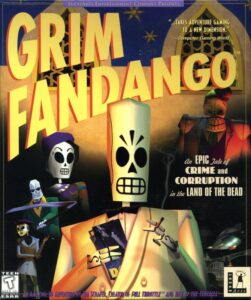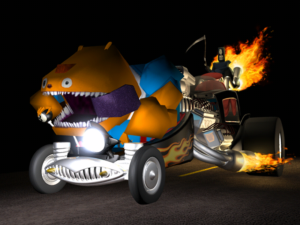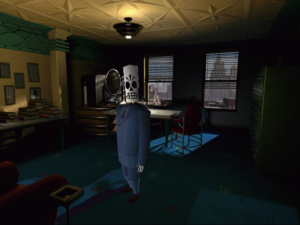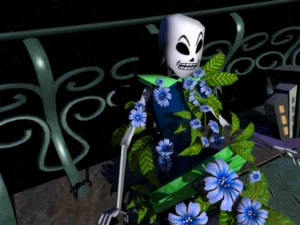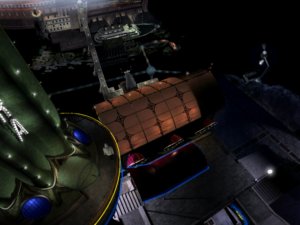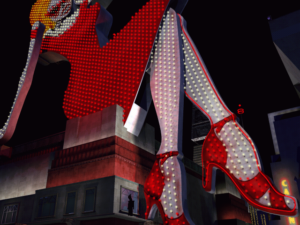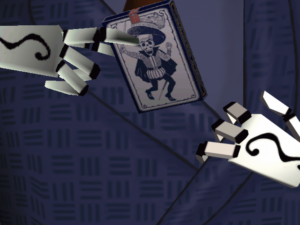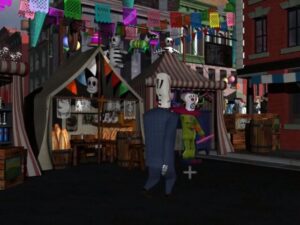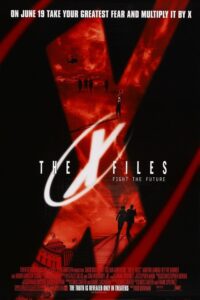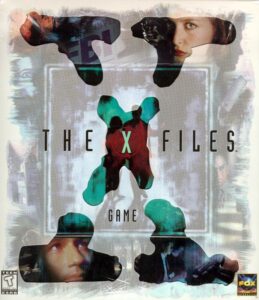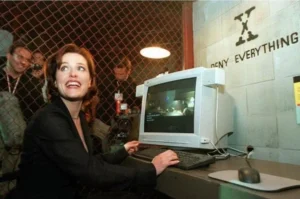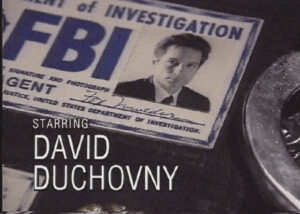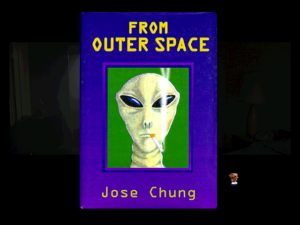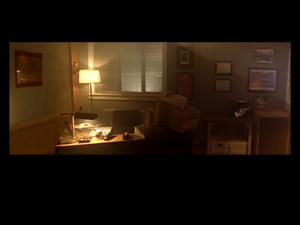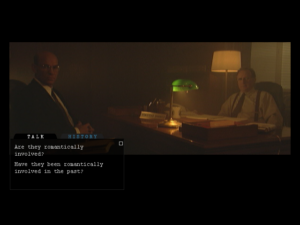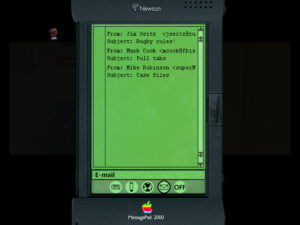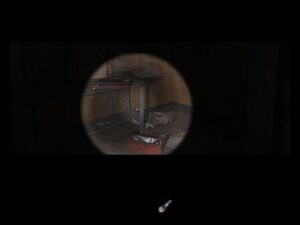In 2002, Paul O’Brian, a prolific author, reviewer, and commentator on the contemporary interactive-fiction scene, attempted to compile a list of those people who had done the most to help text adventures live on beyond the death of Infocom. Among the names he listed were those of Mike Roberts and Graham Nelson, the creators of TADS and Inform; Andrew Plotkin, who contributed crucial technical innovations of his own and authored a number of perplexing, intriguing games; and Adam Cadre, who wrote the single most-played text adventure of the post-Infocom era. None of these names will come as a surprise to anyone who has been even a casual tourist of the interactive-fiction scene over the years. But another of them very well might: that of Gerry Kevin “Whizzard” Wilson. And yet one can make an argument that his skill set was the most unique and thus the most essential of them all.
It will presumably come as a shock to no one when I write that those folks who were still happy to play games consisting of nothing but text in the era of multimedia and 3D tended to be as quiet and bookish as the games themselves. Such personality types are not overly known for their organizing or marketing acumen. The burgeoning interactive-fiction community was thus incredibly lucky to have Wilson, who was the exception to the rule of introversion. An Infocom superfan who just couldn’t bear to see text adventures go gentle into that good night, he became an activist and community organizer par excellence.
In May of 1994, when he was just eighteen years old, Wilson published the first issue of an electronic newsletter which he called SPAG: “Society for the Preservation of Adventure Games.” Later, when it was concluded that text adventures as a species were no longer actively endangered, the word “Preservation” was changed to “Promotion.” By whatever name, SPAG served as the journal of record of the community from 1994 until 2010, a clearinghouse for reviews of the latest games along with news, announcements, and commentary. (Yours truly was the last long-serving editor of SPAG, just before I became a digital antiquarian…)
It was Wilson as well who reached out to Activision, the corporate inheritor of the Infocom legacy. He found an ally there in one Laird Malamed, the project leader of Zork: Grand Inquisitor, Activision’s third and last graphical Zork adventure game. Together, Wilson and Malamed sneaked half a dozen recent amateur-authored text adventures onto the Masterpieces of Infocom shovelware collection. The writers of same even received actual, albeit small, royalty checks for their efforts, meaning that they were, technically speaking, amateurs no longer.
Then Wilson convinced the ex-Infocom authors Marc Blank and Mike Berlyn to write one last text-only Zork, which he himself implemented using Graham Nelson’s Inform programming language and which Activision officially released as a free taster for Grand Inquisitor. These efforts helped to inspire Berlyn to start a new company called Cascade Mountain Publishing; a commercial game from Kevin Wilson and one from Mike Berlyn and his wife Muffy became its only two digital releases. (I’ll have more to say about that ambitious if doomed effort in a later article.) It’s hard to image anyone else in the amateur community orchestrating such sweeping outreach to the world of games beyond the Usenet newsgroups where the Infocom diehards hung out.
But for all the other things he accomplished through his sheer energy, likability, and enthusiasm, the core of Wilson’s claim to being the Indispensable Man in the community will always come down to a single one of the hundreds of messages he posted to Usenet during the 1990s. On June 26, 1995, he announced “The First Annual Text Adventure Authorship Competition,” whose purpose was “to inspire authors to write something, however small, and make it available for people to play. Interactive fiction as a hobby cannot survive unless there are people out there writing and playing it. Hopefully, some of the people who enter the competition will enjoy it, and decide to write more on their own.”
Entrants had to be submitted by September 1 of that year, which in and of itself precluded them from being very long, assuming that each author began his game just for the competition. The entrants were divided into two categories, one for those created with TADS, the other for those created with Inform. The final tally was six entrants in each of the categories, for a dozen new games in all, a massive bounty by the standards of the time. The winners, determined by a popular community vote after a month in which to play the games had elapsed, were Magnus Olsson’s Uncle Zebulon’s Will on the TADS side and Andrew Plotkin’s A Change in the Weather on the Inform side.
Already in this very first year, the entrants bore many of the hallmarks of Comps to come. Some of them were unabashedly experimental in form: Gareth Rees’s The Magic Toyshop took place entirely within a single room; C.E. Forman’s Mystery Science Theater 3000 Presents “Detective” (say that three times fast!) was a meta-textual roasting of a really bad earlier game; Neil deMause’s Undo expected you the player to work around the bugs in another terrible, broken game, a (meta-)fictional one this time. Such games would almost certainly never have come to exist without a Comp to give their authors permission to work on a smaller scale, one that lent itself to such single-concept creations. It encouraged authors to pursue other goals than that of simply being as good as Infocom at the things which Infocom had done best. In this sense, the advent of the Comp marked the beginning of the end of what I referred to as the community’s “neoclassical” phase in an earlier article.
The next year, the same event, now known as The Interactive Fiction Competition, was held again, without the rather pointless division into TADS and Inform categories; authors could now freely choose to use either of those development systems or any other, knowing their games would be judged alongside their peers without favor or prejudice. Another significant change was that the Comp was now more explicitly branded as being for short games, ideally “playable in two hours or less.” This time, it attracted no fewer than 26 entrants, and was won by Graham Nelson’s The Meteor, the Stone, and a Long Glass of Sherbet.
Kevin Wilson unplugged himself from the community after 1998, to aim his prodigious energies in other directions. He became a prominent designer of hobbyist board games, ones that usually had a pronounced narrative thrust and that sometimes borrowed their names and themes from popular digital games like DOOM, Warcraft, and Civilization. Yet his legacy lives on in interactive fiction in the form of the IF Comp, whose 30th installment has been recently concluded as of this writing. Throughout the last three decades, it has remained the essential event on the community’s annual calendar, the sun around which everything else revolves. For community stalwarts, its arrival each year has become as indelible a marker of autumn as the changing color of the leaves, pumpkins on display on roadside stands, and the first nips of Old Man Winter on the breeze.
The positives and negatives of building a community around the IF Comp have been discussed and debated ad nauseam over the years. On the one hand, it surely did encourage many people to take a stab at writing a text adventure who would not have done so back in the days when these games were expected to be as big as one of Infocom’s if they were to be taken seriously. Then, too, as we’ve already seen, it actively encouraged experimentation and innovation. The late 1990s were chock-a-block with games that departed radically from the points-for-treasure model of Zork: self-consciously literary games, games written in bizarre forms of language, one-room games, even a very well received one-turn game.
On the other hand, however, the Comp came to suck up so much of the communal oxygen that some authors felt obligated to enter it in order to get their games noticed at all. And this in turn caused them to write to the specific set of constraints which it encouraged. Although games lasting longer than two hours were never outright disqualified in the official rules, they were guaranteed to provoke some degree of anger among harried judges for being “too long for the Comp,” with some voters giving them bad scores on principle for that sin alone. This produced a not-so-subtle pressure not to make bigger games at all anymore.
On the other other hand, though, the extent of that pressure was probably exaggerated by some. Certainly a steady dribble of big games did continue to appear outside the Comp throughout the latter half of the 1990s. Indeed, an article which I’m planning to write for this site next year will focus on the surprising number of absolutely huge games — most of them far bigger than any made by Infocom — that appeared in 1998 and 1999 alone.
Having said that, I must admit that I do have my fair share of issues with the sorts of games that the Comps of the late 1990s tended to produce. For all that this period may have been a necessary phase for the community to pass through if it was to begin to escape the long shadow of Infocom, a lot of the games themselves really haven’t aged all that well in my opinion. When works in any creative medium start to prioritize meta-textual cleverness — when they become primarily commentaries on the nature of the medium itself instead of the wider world around it — insularity tends to be the result. It’s hard to exempt the interactive-fiction community from this charge — not by the time it was releasing elaborate in-jokes like J. Robinson Wheeler’s Being Andrew Plotkin, which replaced the hero of the film Being John Malkovich with the titular author of modern text adventures. The cliquish — not to say incestuous — feel of games like this did nothing to welcome newcomers into the fold.
Of course, such complaints by no means apply to every single Comp entrant of this period. I’ve brought them up here mainly in order to explain why some types of games will not be much in evidence in the rest of this article, nor in any others on these subjects that might follow it in the future. The late 1990s also brought its share of fine games that are complete in themselves, with no knowledge of the community and its personalities or any of its raging debates about the theory and practice of interactive fiction required. In fact, 1998 can be reasonably called the interactive-fiction community’s best single year in all its history, in that it produced no fewer than three of the most widely played post-commercial text adventures of all time, all of which are included in the little roundup that follows. Each of the games below is possessed of its own authorial voice, distinct from that of any of the people who worked for Infocom. And yet each is as finely calibrated a marriage of plot, place, and puzzles as any of the best games of Infocom — with just one exception, that is, whose reasons for appearing on this list nevertheless will be made clear in due course.
In short, whether it’s your first text adventure or your thousandth, I do think you can enjoy any of the games on this roundup. In the former case, you will have to put in a bit of effort to familiarize yourself with the conventions of the form — but trust me, it’s not all that hard and it’s eminently worth it.
So, why not pick a game and give it a shot? What have you got to lose? Of all the virtues of the text adventures of the 1990s and beyond, the most undeniable is the fact that almost all of them are entirely free. You can try any of these games directly in your browser by clicking the “PLAY ONLINE” link. If you decide to stay with it, you may want to download an offline interpreter and the story file. For the former, I recommend an application called Gargoyle, which will play all of the games below. For the latter, you’ll want to look on the right side of the Interactive Fiction Database page for each game, which you get to by clicking on its title below. (You always want the latest release, generally the first on the list.) Trizbort is a handy application for making maps of the territory you explore. I find filling in a map to be a joy of its own.
I’ve included below a very rough guess as to how long it might take the typical person to play each game. But keep in mind that it’s only a guess. All of these games deserve to be savored for however long strikes you as appropriate.
"This is it!" he says as he dodges the last pothole and brings the truck to a stop. After twenty miles of the worst washboard road the country has to offer, you're just happy to have arrived.
You place your sandaled feet on solid ground and take a deep breath. The smells of autumn are at once sweet and earthy and full of the aroma of moisture and living things. A cool breeze blows in your face, soft and gentle. What a nice change, what a welcome relief from the tension and hustle of all you've left behind this weekend. It's just you and your husband, as he promised over a month ago.
You look around. What passes for the road you just traveled ends abruptly here. Over the last hour, bad asphalt gave way to gravel, which gave way, in turn, to the rutted two-track you see beside you. Ahead, the ruts continue, but it'll be on foot if you're to go any further. The old beater truck stands here, engine off but still ticking from the trip. Your husband closes the driver's door and comes around the rear to join you.
"How's my pretty lady?" he asks as he wraps his arms around you and places a kiss on your cheek from behind. "Tired, huh? Come on. Let's get the stuff. We'll be able to relax better once the tent's up."
He takes the two packs from the back of the truck and helps you into yours, then leads the way through the brush to the north. You roll up on the balls of your feet and give your pack a nudge, then pull the waist strap tight. Without looking back, you follow.
That was last night, and you hiked a short trail to a campsite off in the woods. Together you set up the tent, fixed a quick dinner, and fell asleep in each other's arms...
You wake with a start, something's missing, and you notice the sleeping bag is empty beside you. On his pillow is a handwritten note, which you collect. He must have crawled out early, as the sky is only now beginning to lighten.
You dress quickly, slip out of the tent, and follow the trail to the east.
Aspen Grove
You stand in the middle of a grove of aspen, which extends in all directions. Slender white trunks reach for the sky with long thin fingers, stroking the clouds that blow in the autumn breeze. Leaves of gold rattle as the winds shift, and here and there one floats to the ground to join others that crackle underfoot when you move. A narrow path disappears east into the trees, and a camping area is visible through a small opening to the west. North is a wide meadow.
I was better equipped to appreciate She’s Got a Thing for a Spring when I played it fairly recently than I was when I first encountered it quite some years ago. For it seems that the older I get, the more I just want to be outside walking. In fact, I replayed this game while my wife and I were on a walking holiday in Tuscany, on a morning when the rain was coming down so heavily that there wasn’t anything for it but to stay at our hotel. I sat there on our covered balcony for several hours with my laptop and She’s Got a Thing for a Spring, while the rain pattered and the thunder boomed. I can’t imagine a more perfect soundtrack for this game. Then the storm blew itself out and we went walking again for real.
In She’s Got a Thing for a Spring, which took fourth place in the 1997 IF Comp, you play a wife whose husband has arranged a special treat for your fifth wedding anniversary: a visit to a hidden hot spring somewhere in Colorado or thereabouts. Just to keep it interesting — and to give us a game — he’s first challenged her to find the spring for herself. The stakes are no higher than that. Nor, it must be said, do they need to be.
There’s more personal experience behind this particular interactive fiction than is commonplace in the genre. Beginning one year before and continuing for fourteen years after he released it, our author Brent VanFossen lived full-time with his wife Lorelle in a motor home, exploring the natural wonders of the Americas. He wrote She’s Got a Thing for a Spring, he tells us in his “about” text, as a gift for Lorelle on her birthday. His love for nature and for his wife comes through in every word. There’s a distinct whiff of sensuality to his descriptions of both; said wife is, after all, trying to join him at a hot spring for a secret, skinny-dipping, midnight tryst. In some other games where a male author has tried to embody a female protagonist, it’s gone horribly wrong, coming across as handsy adolescent leering. But this is not that. It’s sexy but not raunchy, sensual but not exploitive. Just the way these things ought to be, in other words.
She’s Got a Thing for a Spring garnered a lot of attention back in the day for the one non-player character with whom you can interact extensively, who is actually not the husband. (He shows up in the flesh only for the last couple of turns.) Said character is rather a humble fellow named Bob, a grandfatherly sort who’s retired to a quiet life in a little cabin in the woods. You can talk to him about an impressive number of topics, both relevant and irrelevant to your quest, as he putters about his house, sweeping the porch, repairing an old rocking chair, picking lettuce and tomatoes and strawberries, making sandwiches for lunch and strawberry shortcake for dessert, fixing a loose plank and re-caulking his windows, painting a picture in watercolors. Throughout, he natters away pleasantly about his chores and about bigger subjects, such as the wife he lost (“Cancer got her, and we never even knew it until it was too late”) and the brother who is coming for a visit soon (“Joe’s an engineer, works on all those commercial jet airplanes in the Northwest”). This is a man who has clearly known pain and loss, yet also one who is completely at peace with himself and his life. Some of that serenity rubs off on the player who spends time with him — or it did on this player, at least. Plus, his strawberry shortcake really is excellent; I tried the recipe that is described step by step in the game after we came home from Italy.
But as special and technically impressive as Bob is, the real magic of this game is the immersion in nature that it provides, which is as complete as the protagonist’s eventual immersion in the spring of its title. You start off with a book — A Field Guide to the Natural History of the Mountainous Regions — already in your possession. You can look up in its pages any of the flora and fauna you encounter during your hiking, to learn a bit more about it from a scientific point of view. Or you can forget about science and its facts and figures for once in your life and just take in the natural world that’s all around you.
The puzzles here do their job by giving structure and motivation to your wanderings. They’re fun to solve whilst being very much in tune with the pastoral atmosphere of their surroundings. There are a few jarring deaths that might have been better elided — you can get yourself gored to death by a bull moose if you aren’t careful — but those are about the only places where the author puts a foot wrong. This is a game about the quiet moments, about peace and beauty and love rather than war and strife and hatred, about the best parts of us rather than the worst. It’s a pity that it’s the only piece of interactive fiction that Brent VanFossen ever wrote. We could use a lot more games like it.
Babel by Ian Finley
Estimated Play Time: four hours
PLAY ONLINE
Black.
White. Cold.
Dry.
The sun is just about to rise on latitude 74. In the darkness the last stars
pierce the air and the arctic wind is a dying songbird. Below the snow dunes,
you are waking. Something is wrong.
North End
One by one, your senses speak to you. There is one absolute: cold. The
hard surface you're lying on is cold, the thin gown thrown over your body is
cold, the disinfectant-tinged air is cold, the darkness around you is cold.
Even your mind is cold and empty. Where are you? Who are you? You feel the
warm edge of a memory, but it fades as you approach. Slowly, your joints
bulging with ache, you get to your feet and look around.
You're standing in a cold, dimly lit hall which runs south toward a feeble light and terminates at a door to the north, out of which juts a weird device. Next to the door, in the northeast corner, is a heavy bulkhead, and you can just make out a third door on the west wall.
Babel is the first of three games that were authored between 1997 and 2000 by Ian Finley, a professional playwright, actor, and theater instructor. As a game with points and puzzles and most of the other standard accoutrements of the traditional text adventure, it is by far the most conventional of the trio. It placed second in the 1997 IF Comp.
Babel’s setting and premise verge on the clichéd. It takes place in an isolated polar research complex where Horrible Things transpire, a staple premise for science fiction and horror stretching back many, many decades. Yet the game serves as proof that execution will always trump whole-cloth invention. Few works of narrative art have done claustrophobic dread better than this one.
There is an interesting twist to the premise here. The Horrible Things in question have already happened as the game begins, when you come to consciousness shivering in the frigid air inside a complex that is now inhabited only by the corpses of your former colleagues. (Yes, an amnesic protagonist is an even more hackneyed cliché than the isolated research complex gone wrong, but remember what I said about execution.) As you begin to explore, knowledge of what happened comes back to you in the form of sudden flashes of memory that are like psychotic breaks, so jarring and traumatic are they. The sense of foreboding — of dawning knowledge that you’d prefer not to have — mounts and mounts as you solve a series of quite simple, straightforward puzzles to gain access to more and more of the complex and unlock more and more of your own unconscious. At last, it all comes to a head in a hair-raisingly twisted ending.
Babel did garner some criticism in its day for taking the easy way out with its storytelling. Relying on the classic gambit of uncovering a backstory rather than participating in a full-blown drama in the here and now lets it sidestep most of the difficulties of doing elaborate plotting through the mechanisms of text and parser. Yet what another critic might call a cop-out, I call making smart use of the tools at one’s disposal; ironic though it is to say this about a medium that likes to go by the name of “interactive fiction,” novelistic storytelling isn’t what parser-driven games tend to do best. Tying Babel’s story so closely to exploration — something interactive fiction does do very well — strikes me as thoroughly sensible.
I certainly can’t argue with the results here. Babel is a masterclass in tension, dread, and atmosphere, the perfect game to play in front of the fire on some cold, dark winter night when the snow is piling up alarmingly high on the other side of the window.
Spider and Web by Andrew Plotkin
Estimated Play Time: four hours
PLAY ONLINE
On the whole, it was worth the trip. The plains really were broad and grain-gold, if scarred with fences and agricultural crawlers. The mountains were overwhelming. And however much of the capital city is crusted with squat brick and faceless concrete hulks, there are still flashes of its historic charm. You've seen spires above the streets -- tiny green parks below tenements -- hidden jewels of fountains beyond walls. Any bland alley can conceal balconies wrought into iron gardens, fiery mosaics, a tree or bed of flowers nurtured by who knows who.
This alley, however, is a total washout. It ends in flat bare dirty brick, and you've found nothing but a door which lacks even the courtesy of a handle. Maybe you should call it a day.
End of Alley
It's a narrow dead end here, with walls rising oppressively high in three directions. The alley is quite empty, bare even of trash. (Your guidebook warned you: the police are as efficient about litter laws as about everything else they do.) You can retreat to the south.
A plain metal door faces you to the east, near the alley's end. It's firmly shut.
Following the example of Paul O’Brian, I don’t hesitate for a moment to stand Andrew Plotkin up alongside Mike Roberts and Graham Nelson as one of the people who did the most to keep the humble text adventure alive during the 1990s and beyond. In addition to a whole raft of vital technical and administrative contributions, he has written more important and highly lauded games over a longer span of time than anyone else. Many of them are slyly subversive; he has a gift for translating the interior of his protagonists’ minds into landscapes that aren’t quite what they appear to be. If I was forced to point to a weakness in his work, however, I might say that he has sometimes made his player work a little too hard for her experience, especially during the early phase of his career. A minimalist by instinct, his early games don’t exactly bend over backward to welcome the player in. “Here I am,” they seem to say. “Come inside if you like. I don’t really care one way or the other.”
But Spider and Web doesn’t have that problem, if problem it be. The deft opening above, seemingly written from the point of view of an adventurous tourist on a visit to an unnamed Eastern European country during the Cold War era, definitely has no trouble capturing my interest. Coincidentally or not, this game, which Plotkin released in February of 1998, is still regarded by many or most text-adventure aficionados as his masterpiece. I count myself among their number.
Spider and Web is an exploration of the old fictional trope of the unreliable narrator, carried out in a way that would be impossible in a non-interactive medium. I can best explain some of what it’s doing by describing how its first handful of turns are likely play out for you. In the role of the tourist, you poke and fiddle with the inscrutably blank door in front of you for a while, until, seeing no way to get through it, you walk off to discover what else lies to the south. As soon as you do so, a “glaring light” appears before your eyes, and you find yourself in an interrogation chamber. “Don’t be absurd,” says your interrogator. “You’re no more a sightseer than the Old Tree in Capitol Square; and if you’d had enough sense to walk away from that door, you wouldn’t be here. You’re going to start by telling me how you got through that door.”
And then you’re thrown back to the start of the game. But this time the opening text is subtly different.
On the whole, it was worth the trip. The plains really were broad and grain-gold, if scarred with fences and agricultural crawlers. The mountains were overwhelming. And however much of the capital city is scarred with squat brick and faceless concrete hulks, there are still flashes of its historic charm.
This alley, however, has no time for charm. It ends in flat bare dirty brick, and a door which lacks even the courtesy of a handle. Not that you'll wait on courtesy.
End of Alley
It's a narrow dead end here, with walls rising oppressively high in three directions. The alley is quite empty, bare even of trash. (You're sure the police are as efficient about litter laws as about everything else they do.) You can retreat to the south.
A plain metal door faces you to the east, near the alley's end. It's firmly shut.
From here on, you keep trying to tell your interrogator a story that minimizes your exposure as a foreign agent and saboteur, and he keeps calling you out on it, forcing you to change the details.
Until, that is, deep into the game, when you arrive at the moment that changes everything. People tend to refer to this moment as simply The Puzzle. It’s not an enormously difficult puzzle, but it’s nonetheless been called, with no hyperbole whatsoever, the best text-adventure puzzle of all time, all of the games of Infocom included. It’s far too brilliant to spoil here, but suffice to say that, when the light bulb does goes off in your head and you feverishly type the necessary command and see that you were right, you’ll be jumping out of your chair and pumping your fist as if you’ve just defeated the last boss in Dark Souls. The roles of the spider and the insect trapped in its web will have reversed themselves, and it will feel amazing.
After that, Spider and Web is just a chase scene, albeit a very well-executed one. But my, what a genius conceit comes before it, and what a genius puzzle to bring the conceit to its perfect fruition. Epistemology was never so much fun.
(A quick programming note: an extended interview with Andrew Plotkin is coming to this site soon.)
Anchorhead by Michael Gentry
Estimated Play Time: ten hours
PLAY ONLINE
November, 1997.
You take a deep breath of salty air as the first raindrops begin to spatter the pavement, and the swollen, slate-colored clouds that blanket the sky mutter ominous portents amongst themselves over the little coastal town of Anchorhead.
Squinting up into the glowering storm, you wonder how everything managed to happen so fast. The strange phone call over a month ago, from a lawyer claiming to represent the estate of some distant branch of Michael's family, was bewildering enough in itself... but then the sudden whirlwind of planning and decisions, legal details and travel arrangements, the packing up and shipping away of your entire home, your entire life...
Now suddenly here you are, after driving for the past two days straight, over a thousand miles away from the familiar warmth of Texas, getting ready to move into the ancestral mansion of a clan of relatives so far removed that not even Michael has ever heard of them. And you've only been married since June and none of this was any of your idea in the first place, and already it's starting to rain.
These days, you often find yourself feeling confused and uprooted.
You shake yourself and force the melancholy thoughts from your head, trying to focus on the errand at hand. You're to meet with the real estate agent and pick up the keys to your new house while Michael runs across town to take care of some paperwork at the university. He'll be back to pick you up in a few minutes, and then the two of you can begin the long, precarious process of settling in.
A sullen belch emanates from the clouds, and the rain starts coming down harder -- fat, cold drops smacking loudly against the cobblestones. Shouldn't it be snowing in New England at this time of year? With a sigh, you open your umbrella.
Outside the Real Estate Office
A grim little cul-de-sac, tucked away in a corner of the claustrophobic tangle of narrow, twisting avenues that largely constitute the older portion of Anchorhead. Like most of the streets in this city, it is ancient, shadowy, and leads essentially nowhere. The lane ends here at the real estate agent's office, which lies to the east, and winds its way back toward the center of town to the west. A narrow, garbage-choked alley opens to the southeast.
“Anyone who had ever read anything by H.P. Lovecraft, or even stood downwind of someone who has, will immediately recognize his influence throughout this game,” writes Michael Gentry in his introductory notes for Anchorhead. And indeed, this sprawling game, which Gentry released in May of 1998, is to my mind the definitive work of digital Lovecraftia, easily outdoing the likes of The Lurking Horror and Alone in the Dark.
Like all of the best Lovecraft homages, Anchorhead succeeds by embracing the best parts of its inspiration and binning the worst. Our protagonist here is a strong, capable woman, something that was well beyond the most fevered imaginings of old Howard himself. Along with the rampant misogyny, gone too is the almost unbelievably virulent racism that is at the core of so much of the man’s output. And I’m almost equally happy to be able to say that Gentry is adept at capturing the flavor of Lovecraft’s prose without descending into the pseudo-eighteenth-century word salads for which his inspiration is so famous. Yet the horror at the heart of Anchorhead is the same existential dread, the same indelible product of the modern secular condition onto which Lovecraft stumbled. It isn’t the horror of malevolent godlike entities; it is the horror of godlike entities who care about human beings no more than we care about the ants we trample underfoot.
You play a young wife, married less than half a year, whose husband, a soft-spoken professor of history, has just received an unexpected inheritance from relatives he never knew he had in the New England harbor town of Anchorhead. So, the two of you have upped stakes to move halfway across the country, into a palatial if rather sinister-looking abode at the edge of town. But now your husband is starting to behave strangely, almost as if he’s fallen under some sort of spell.
The core of this game’s strange allure is the downtrodden town of Anchorhead itself. As you play, you can see its sad gray walls and cobblestones under its sad gray skies; hear the forlorn cawing of seagulls and the background hum of the waves; feel cold rain on your hair and wet moss on your hands; taste the sour sea breeze; smell the stale tobacco of the sulky old men who spend their days drinking up the gloom in the world’s least cozy tavern. Few places in interactive fiction have ever been as thoroughly realized as this one. It’s deliciously repulsive.
Add onto this geographical framework the plot, which is the definition of a slow burn. You spend the first half or more of the game mainly conducting research, uncovering more and more ominous details about your husband’s cursed heritage. Finally, your mounting forebodings explode into some frantic scenes of terror. Even in the game’s latter half, however, Gentry understands that effective horror is a matter of tension and release. He knows when to pour it on and when to ease the pressure, to let you catch your breath and recover your frazzled wits before your next peek into the abyss.
Anchorhead does a superb job of integrating its puzzles, if that’s what we wish to call them, into this vivid setting and unfolding plot. They’re never arbitrary, but consistently driven by your need to find out more. Then, once you’ve found out all too much, you have to find a way to survive the forces unleashed against you, to save your husband from a fate worse than death, and possibly to save the entire planet while you’re at it. If you read through the fruits of your research carefully and do the thing that seems most logical in some admittedly awful circumstances, you’ll find that that thing generally works about as well as can be expected.
Play it, live it, and learn to love its eldritch blasphemies. Scary text adventures — heck, ludic horror in general — simply don’t get any better than Anchorhead, folks.
(Do note that, in addition to the free version from 1998, Michael Gentry made available an enhanced twentieth-anniversary edition of this landmark game in 2018, with additional scenes, puzzles, and details, plus 50 illustrations to accompany the text. He’s also tinkered with the design to remove some unwinnable situations and added some features to make the game more newbie friendly in general. I haven’t played this version yet, but I have no reason to doubt that it makes a great game even better. If I was playing Anchorhead for the first time, this is definitely the version I’d go for. The price of $10 is very reasonable for a game of this size and scope.)
The Plant by Michael J. Roberts
Estimated Play Time: five hours
PLAY ONLINE
You're just starting to doze off when a jerking motion brings you back to
alertness. You look over to see your boss, Mr. Teeterwaller, struggling to
steer the car onto the shoulder as the engine dies. You can see that all of
the dashboard lights are on as the car jerks to a stop.
This is turning into a fine business trip. First Mr. Teeterwaller insists on
making the five-hour car trip in the middle of the night so the company won't
have to pay for a hotel, then you spend an hour stuck behind a convoy of slow
trucks on Teeterwaller's two-lane supposed short-cut, and now his aging
bargain-basement car strands you out in the middle of nowhere.
Teeterwaller turns off the headlights and turns on the hazard lights. "I just had this thing in the shop," he mumbles.
In the car
The Toyunchknisk Piglet was imported from Blottnya during the brief period
between the fall of the old iron-fisted regime and the ethnic unrest that
divided the tiny country into several even tinier countries whose names you
can't recall, since the press lost interest several years ago. The car is
almost comically spartan, so it's just like your boss to own one. The only
amenity the dashboard offers is a glove compartment; no radio, no air
conditioner, no console armrest, no cup-holders.
You're sitting in the rather uncomfortable passenger's seat. The driver's door is closed, and your door is closed.
Sitting on the back seat is a jacket, a map, a Project Tyche manual, and a magazine. The ignition seems to contain a car key.
Your boss Mr. Teeterwaller is here.
You're carrying your temporary ID card.
Mike Roberts’s The Plant, which took third place in the 1998 IF Competition in spite of a considerable number of complaints that it was “too big for the Comp,” is in some ways the most old-school game in this roundup, a sturdy puzzlefest without any overt agenda beyond that of entertaining you. In another sense, though, it’s the most inextricably bound to the late 1990s. For it positively radiates the influence of The X-Files, which was right at the zenith of its popularity at the time this game was released. In terms of plot and setting, The Plant plays like one of the show’s more comedic, postmodern episodes — perhaps one of those written by Darin Morgan or Vince Gilligan, the sort where you never quite know where earnestness ends and satire begins.
The plant of the title isn’t the kind that grows in dirt, but rather a strange factory complex that you stumble upon on a road trip with your boss, the skinflint Mr. Teeterwaller, in the latter’s Toyunchknisk Piglet, a car which makes a Yugo seem like a Mercedes. The tropes of 1990s conspiracy culture are rolled out one by one: desolate desert highways, convoys of unmarked trucks driving through the dead of night carrying who knows what, anonymous men in black, impossible technologies that seem unlikely to be of terrestrial origin, riddles piled upon mysteries piled upon enigmas. A ufologist magazine you find, demanding “an investigation into a previous investigation of an alleged coverup,” might easily have been found in the X-Files episode “Jose Chung’s From Outer Space.”
It’s all fodder for a well-crafted, good-natured, slightly goofy text adventure of the sort at which Mike Roberts excels. There are a lot of really enjoyable puzzles here, not too hard but not too trivial either, and always meticulously fair. The Plant breaks no new ground whatsoever, but it does provide a rollicking good time from start to finish. Its secret weapon is Mr. Teeterwaller, who follows you around over dune and dale, up ladders and elevators and scaffolds, mumbling and fretting all the while but never abandoning you. He seems useless — until suddenly he isn’t.
In his review of The Plant, Paul O’Brian recommended it most of all to those who were “a little impatient with all the growing that the medium of interactive fiction is doing, and long for a good old-fashioned Infocom-style thrill ride.” Although O’Brian’s overall review is very positive, that sentence is too dismissive by half; the sort of game we have here is exactly the one that the medium of text and parser was invented to provide, and is still the one for which it is most intrinsically suited. The Plant’s stolid old-school approach has aged better than that of many of the games that once thought they represented the future of the medium.
Photopia by Adam Cadre
Estimated Play Time: one hour
PLAY ONLINE
Speeding down Montgomery Boulevard
The streetlights are bright. Unbearably bright. You have to squint as hard as you can to keep your retinas from bursting into flame.
"Welcome back to the land of the LIVING, bud," Rob says. "You planning to stick around for a while or you gonna pass out again? Cause one thing I've learned about chicks is that they actually DON'T LIKE IT when you pass out on them in the middle of gettin' it on. You hear me? So if that's, like, your PLAN, then I'm droppin' you off and showin' up solo."
You don't exactly remember where the day went, but as you listen to Rob rant on, bits of it start to float back to you: a day on the slopes, the brisk February wind against your face; polishing off a keg back at the lodge; those two girls you and Rob had hit it off with, the ones who'd given you their address in town. "We all should get together sometime!" they'd said. Of course, Rob insisted that by "sometime" they'd meant "later tonight." You hadn't been so sure, but then you'd blacked out before you could argue the point.
How Rob came to be driving your car you're not exactly sure. Apparently he couldn't wait till you were sober enough to drive it yourself. From the way he's weaving all over the road, he also apparently couldn't wait till HE was sober enough to drive it, either.
Rob checks himself out in the rearview mirror. "Man, I am one handsome dude," he says approvingly.
And so we come to the smallest game on this list, which is nevertheless The Big One of 1998, even more so than Spider and Web or Anchorhead. In fact, Adam Cadre’s Photopia is without a doubt the best-known and most-played parser-based interactive fiction of the entire post-Infocom era. The winner of the 1998 IF Comp, it has today twice as many ratings as any other game on The Interactive Fiction Database, and has been written up countless times in magazines and websites that normally don’t cover this sort of thing. Thousands upon thousands of people over the years have found it a profoundly moving work of literature. I would never presume to tell these people that they’re wrong to feel as they do. Yet I do have to say that I’m somewhat less smitten.
Photopia is about a teenage girl named Alley, but you never inhabit her directly. Instead you see her from the perspectives of other people in her life. You spend the most time as Wendy, a much younger girl whom she babysits. The two make up stories together in which Wendy is an astronaut or an undersea explorer. As they do so, Alley effectively becomes the computer game with which you are interacting, a gimmick which hearkens to the text adventure’s origins in the shared story spaces of tabletop Dungeons & Dragons. “Read you a story?” asks Alley of her charge. “What fun would that be? I’ve got a better idea: let’s tell a story together.”
But there are also vignettes from the real world, in which you see Alley through the eyes of her mother, her father, and the boy at school who has a crush on her. Most searingly, you briefly inhabit Wendy’s father, who is driving Alley home from her babysitting gig when his car gets side-swiped by a drunk driver, killing his young passenger instantly.
Photopia is almost completely puzzle-less. That said, the one interaction that might be construed as a puzzle is the most transcendent moment in the game. As with The Puzzle in Spider and Web, the solution to this one comes in a dazzling rush of insight. It serves as the ideal therapy for anyone who’s tired to death of the boring, drop-em-and-map-em mazes that are found in so many old-school text adventures. To say any more would be to spoil another of the most magical moments in all of interactive fiction.
Otherwise, though, Photopia falls a little flat for me, no matter how hard I try to love it like so many other people do. Its one amazing puzzle and the meta-textual cleverness of the story you and Alley tell together can’t overcome the emotional immaturity of the fiction as a whole. This is the poison pill that comes with taking text adventures up-market. When you invite me to consider your piece as a game, I compare it with other games; when you invite me to consider it as deathless fiction, I start to compare it with truly deathless fictions.
At bottom, Alley is as much a male-adolescent fantasy as Lara Croft. She’s a nerd-friendly version of a Manic Pixie Dream Girl: “She’s beautiful and nice and she likes science!” We never learn a single bad or even ambivalent thing about her. She’s sweet and loving to her parents, the kind of girl who likes to do science projects in the garage and lie on a blanket at night beside her father cataloging the stars overhead. She navigates the savage politics of high school with preternatural aplomb, being friends with all and cruel to none. And, as we’ve seen, she’s never too tired or distracted to spin endlessly imaginative yarns for the little girl she babysits. Simply put, she’s too perfect to be real. Has she no discontents at all? Is she never in a bad mood? Has she any inner life at all? To mow down this Hallmark movie version of a teenage girl with a drunk driver at the end smacks more of bathos than pathos.
Adam Cadre was a very young man when he wrote Photopia. I fancy that it shows. Tellingly, the most successful part of the story is the one written from the point of view of a character who is, I suspect, the closest to the author himself: the boy in Alley’s school who’s crazy about her. I can remember seeing the girls I crushed on when I was his age in just the way he does: as magical creatures, as far above the mundane day-to-day of life as the angels painted on the ceiling of a cathedral. What I didn’t understand back then was that, in insisting on seeing them this way, I was refusing to see them as fully actualized flesh-and-blood human beings just like me. I don’t get the feeling that Cadre fully understood this yet at the time he wrote Photopia.
Still, stickily sentimental though I find Photopia to be, by no means do I want to discourage you from playing it. Even if you come away seeing it as a snapshot of a certain stage in male rather than female adolescence, as I tend to do, that too has a resonance all its own. (Ah, to be sixteen again… an age at which I would probably have adored this game, had it existed then.) Then, too, there’s no denying Photopia’s importance to the history of its medium. And it has the virtue of being short, with that one magical moment that’s well worth investing an hour of your life to experience. As for the rest of it… who knows? You might find that you unabashedly love it. Plenty of people whose opinions are every bit as valid as mine do.
Did you enjoy this article? If so, please think about pitching in to help me make many more like it. You can pledge any amount you like.


